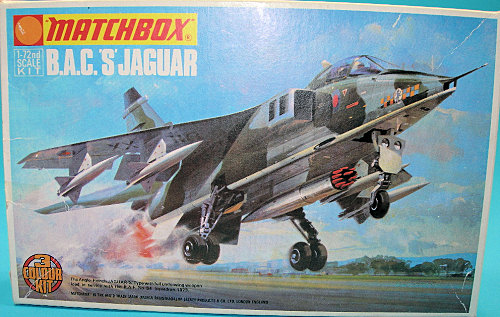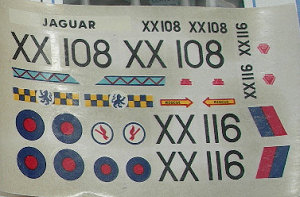
| KIT: | Matchbox 1/72 Jaguar 'S' |
| KIT #: | PK-102 |
| PRICE: | Long out of production |
| DECALS: | Two options |
| REVIEWER: | Victor Scheuerman |
| NOTES: | Issued in 1973 |

| HISTORY |
Vic was so into the article that he forgot the history section. Here is one courtesy of http://en.wikipedia.org:
The Jaguar program began in the early 1960s, in response to a British requirement for an advanced supersonic jet trainer, and a French need for a cheap, subsonic dual role trainer and attack aircraft with good short field performance. From these apparently disparate aims would come a single and entirely different aircraft: relatively high-tech, supersonic, and optimised for ground attack in a high-threat environment. It was planned as a replacement for the RAF Hawker Hunter and the Armée de l'Air F-100 Super Sabre.
Cross-channel negotiations led to the formation of SEPECAT (the Société Européenne de Production de l'Avion d'École de Combat et d'Appui Tactique) in 1966 as a joint venture between Bréguet -now Dassault Aviation- and the British Aircraft Corporation to produce the airframe, and a separate teaming of Rolls-Royce and Turboméca to develop the Adour afterburning turbofan engine. Though based in part on the Breguet 121, using the same basic configuration and an innovative French designed landing gear, the Jaguar as built also incorporated major elements designed by BAC - notably the wing and high lift devices.
The first of 8 prototypes flew on September 8 1968. It was an orthodox single-seat, swept-wing, twin-engine design but with tall landing gear. It had a maximum take-off weight in the 15 tonne class and could manage a combat radius on internal fuel alone of 850 km. Maximum speed was Mach 1.6 (Mach 1.1 at sea level) and hardpoints were fitted for an external weapons load of up to 10,000 lb.
The Jaguar S is what the RAF's Jaguar GR.1 was called while in the development/prototype stage.
| THE KIT |
 As
was the norm for the 100 series of the Matchbox range, the 54 parts (included a
clear one-piece canopy) are molded in three colours; grey, light and medium
brown. The moldings are flash free and all the panel lines are engraved but
would look less pronounced with a light sanding and a darker camouflage finish.
Detail parts for the office consist of an ejection seat that at least has a head
rest and a quality sculpted pilot. There is a hint of an instrument panel and
the roof of the nose gear bay doubles as the floor. A robust looking landing
gear is supplied but the somewhat complicated configured main legs are
simplified and all the tires appear to be too wide, especially the nose.
However, all the bays are framed in and the doors would look fine after being
sanded a little thinner.
As
was the norm for the 100 series of the Matchbox range, the 54 parts (included a
clear one-piece canopy) are molded in three colours; grey, light and medium
brown. The moldings are flash free and all the panel lines are engraved but
would look less pronounced with a light sanding and a darker camouflage finish.
Detail parts for the office consist of an ejection seat that at least has a head
rest and a quality sculpted pilot. There is a hint of an instrument panel and
the roof of the nose gear bay doubles as the floor. A robust looking landing
gear is supplied but the somewhat complicated configured main legs are
simplified and all the tires appear to be too wide, especially the nose.
However, all the bays are framed in and the doors would look fine after being
sanded a little thinner.
External stores include a fuselage
located fuel tank/rocket pod and four Martel missiles (lo ok
nice) are supplied for the separate wing pylons. Intakes are separate with
separate splitter plates (trim back the RAF 54 Squadron version) and look good
while the afterburners have no detail or depth. Matchbox instructions are well
drawn and easy to follow with the detail interior painting notes at the end.
ok
nice) are supplied for the separate wing pylons. Intakes are separate with
separate splitter plates (trim back the RAF 54 Squadron version) and look good
while the afterburners have no detail or depth. Matchbox instructions are well
drawn and easy to follow with the detail interior painting notes at the end.
Two decal options are offered and both are low-viz RAF machines with the dark green and dark grey over light grey. One is a 54 Squadron Jaguar and this has the tasteful blue and yellow checkered squadron insignia on the forward fuselage. In identical finish is a 6 Squadron (the famous flying can-openers) that has their readily identifiable crest on the forward fuselage with the squadron colours displayed in a band across the upper vertical tail. These decals still look good and both schemes are shown in full colour on the box back.
| CONCLUSIONS |
Obviously not in the same league as the Hasegawa, Italeri or even the Airfix kit for that matter. However, it’s the type of kit (engraved with framed wheel wells) that I would look for some prototype (French Navy) or proposed prototype to make a version of.
June 2007
If you would like your product reviewed fairly and quickly by a site that has over 350,000 visitors a month, please contact me or see other details in the Note to Contributors.